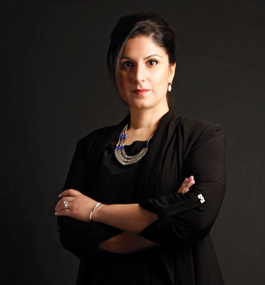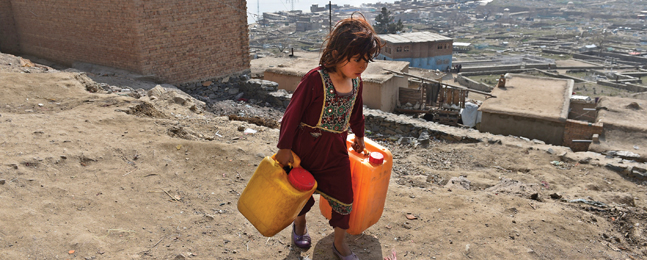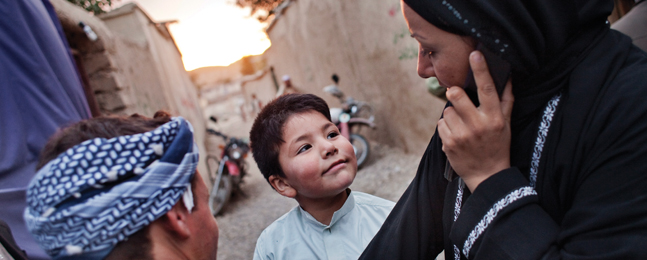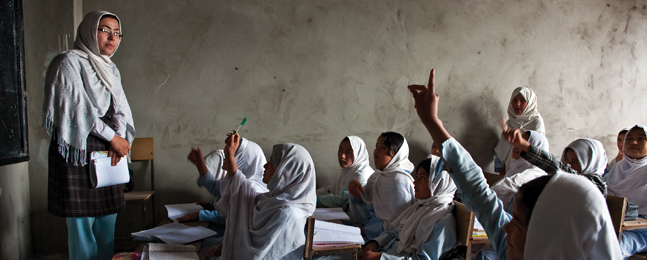The Stories They Would Tell
Nadia Hashimi ’00 writes novels that uncover the complicated, difficult lives of Afghan women and children.

Mike Lovett
Nadia Hashimi '00
by Susan Piland
Afghanistan is a bleak place to be female.
Westerners know some of the reasons why: Men have the power to control the lives of their wives and daughters, sometimes cruelly. Without a husband or a father, a woman is a cipher in her community. The idea of women’s rights is still widely resisted.
Statistics add more telling detail. According to Amnesty International, only a third of students enrolled in Afghanistan schools are girls. A mere 13 percent of Afghan women 16 and older can read and write, compared to 43 percent of the country’s men. Eighty-seven percent of Afghan women endure domestic violence. Most Afghan women won’t live to be 50.
As startling as these facts are, they don’t reveal what it’s like to be a woman in Afghanistan, what her world looks like from the inside. So Nadia Hashimi ’00, a pediatrician living in Potomac, Md., whose parents immigrated to the U.S. from Afghanistan before the 1979 Soviet invasion, decided to remedy that.
She wrote a novel.
“The Pearl That Broke Its Shell” follows the lives of two Afghan women, told in intertwining narratives. Shekiba contends with violence and privation at the turn of the 20th century; her great-great-granddaughter, Rahima, faces disturbingly similar challenges 100 years later. The debut novel, published last year by William Morrow, quickly attracted admirers, including Khaled Hosseini, the author of “The Kite Runner” and “A Thousand Splendid Suns” (and a physician himself), who called Hashimi’s story “an always engaging multigenerational tale … a portrait of Afghanistan in all of its perplexing, enigmatic glory, and a mirror into the still ongoing struggles of Afghan women.”
Much of the buzz around the novel focuses on its explication of a little-known practice called bacha posh, in which Afghan families without sons dress up a daughter in boy’s clothes, and treat her as a son. Afghanistan is such a closed society that, until very recently, almost no one in the West had any idea the practice even existed.
As the book’s title — drawn from a 13th-century poem by Rumi — suggests, the two “Pearl” protagonists are willing to do what it takes to get out of the airless spaces that confine Afghan women.
“Everyone is telling them, ‘Girls don’t do that. You can’t do that. That’s not yours. You shouldn’t have anything like that,’” Hashimi says. “But Shekiba and Rahima think, Why? Maybe I do deserve that.
“Women who have that little instinct can make it beyond the threshold their world sets for them.”
Mirror images, generations apart
Aspirations are dangerous for women like Shekiba and Rahima. Their life is a minefield. Living through the day is struggle enough.
With a face badly burned by cooking oil when she was a toddler, Shekiba is an outcast in her rural village. Her siblings die in a cholera epidemic. Her worn-to-the-bone parents follow soon thereafter. Conniving relatives grab her father’s land and keep her as a menial servant, then give her away to slave for another family. Eventually, improbably, scarred Shekiba becomes one of the women who dress and live as men to guard the Afghan king’s harem (a historically accurate detail).
A century later, Rahima lives with an opium-addicted father, a loving but weak mother, and four sisters. Needing a son, Rahima’s parents make her a bacha posh (Dari for “dressed like a boy”) so she can escort her sisters outside the house, run errands and hold a part-time job.
“I tested an old man walking by,” Rahima says about her first errand as a boy. “I looked directly at him, meeting his squinted eyes and seeing that he didn’t react to my forwardness. Thrilled, I started to run faster. No one gave me a second glance. My legs felt liberated as I ran through the streets without my knees slapping against my skirt and without worrying about chastising eyes. I was a young man, and it was in my nature to run.”
Her intoxicating taste of freedom as a bacha posh ends abruptly when her father marries her and her two elder sisters to much older men in exchange for money and drugs. Rahima, just 13, becomes the fourth wife of a brutish warlord in his 40s, and quickly bears a son, Jahangir. Her sister Parwin, unable to endure her own marriage, ends her suffering by self-immolation.

Shah Marai / AFP / Getty Images
ALONG A HARSH PATH: A girl carries containers filled with water to her home in a hillside neighborhood in Kabul.
page 2 of 4
As the characters’ worlds close in on them, Hashimi’s skill as a storyteller keeps the reader on edge, wondering, Will they survive? Could I have survived?
“When I tried to picture myself in 10 years, it was frightening,” young Rahima says. “My hands were already rough and knobby. My back ached at night, partly from carrying Jahangir for nine months and partly from being bent over to wash clothes and scrub floors most days. This home, this life, had aged me. Maybe that was what Parwin had seen, life in 10 years. Maybe it was a sight too ugly to bear.
“Everyone needs an escape.”
To give the girl strength, Rahima’s aunt tells her about Shekiba’s life, the story within the story. “I wanted Rahima to know that she descends from someone who managed to get all the way to the king’s palace,” Hashimi says. “To know that the same blood courses through her veins, as she tries to overcome almost insurmountable challenges.”
The challenges Shekiba and Rahima face are so similar, it’s as though Afghanistan was frozen in time for 100 years. But that’s not the case. In fact, Afghan women enjoyed a period of relative freedom in the 20th century. Unfortunately, it didn’t last.
A golden age
Shekiba is able to glimpse the dawn of a more permissive period, when a new, progressive king — with a well-educated wife, who dresses in Western clothes and refuses to wear a veil — takes the Afghan throne in 1919. Dress codes for women were loosened. Education for girls was encouraged. Polygamy was discouraged.
The ripple effects were felt for years. “That golden age for women, that’s my mother’s Afghanistan,” says Hashimi. “She and her five sisters all went to college. They had a lot of mobility within society as well.”
Hashimi’s mother was one of the first women to enroll in Kabul University’s engineering program. After graduating, she won a scholarship to go to the Netherlands for a master’s in civil engineering. One of her sisters worked for the United Nations. Another worked for the airlines.
“The photos from back then are so incredible,” Hashimi says. “Women are wearing short sleeves and skirts that fall just below the knee.”
Hashimi’s mother and father met and got engaged in Afghanistan. Her father moved to the U.S. in 1971, and her mother followed in 1974, after completing her master’s. The couple married in the U.S. They worked in restaurants, then bought several fried-chicken places in New York City. They had Nadia and, two years later, a son, Fawod. In 1989, the family moved to Warwick, N.Y., after purchasing a delicatessen there with another relative.
Originally, Hashimi’s parents had planned to work in the U.S. for just a few years, then return home. But war got in the way. “Afghanistan was invaded by the Soviets, and my parents didn’t want to return to a country at war,” Hashimi says. “And then the war went on for decades.”
As the conflicts raged, she says, “it was difficult for my parents to turn on the TV and see a very different Afghanistan than the one they had grown up in. Their country was getting further and further away from them. They couldn’t recognize it anymore.”
In 2002, after the U.S. invaded to remove the Taliban from power, Hashimi’s parents traveled back to Afghanistan for the first time. Nadia went with them. “It was a very odd trip,” she says. “Everything had changed so much. My parents felt like outsiders in their homeland. Kabul, the city they grew up in, was devastated by all the fighting. We found the street where my mother grew up, but the only part of her childhood home still standing was the corner of a bannister.”
There were signs of new life: new buildings going up, busy streets, crowded markets. “My parents saw a lot of hope,” Hashimi says. “But at the same time they saw a lot of what had been lost.”
Temporary boys
Bacha posh, which Rahima lives and Shekiba experiences a quasi version of as a harem guard, appears to be a relatively recent phenomenon in Afghanistan.
“From my research, it seems bacha posh goes back about a hundred years,” Hashimi says. “It’s not based on religion at all. It’s a cultural thing. And variations of a cross-dressing practice exist in other parts of the world, too, like Albania.”
Bacha posh began because deeply patriarchal societies like Afghanistan need sons. When boys can do everything and girls can do almost nothing, a family dramatically eases its burdens by creating a son.
There’s also some superstition bound up in the practice, Hashimi says. Dress one of your daughters as a boy, the thinking goes, and you improve your chances your next child will actually be a boy.
The suspension of disbelief that bacha posh depends upon — family members and neighbors willingly accepting that little Rahim, who yesterday was little Rahima, is entitled to all the freedoms that come with being male — can seem odd to Westerners. Hashimi says that Afghans simply see the practice as a necessary work-around.
“If you devalue women, and you shame a family without sons, you’re compelled to create a solution,” she says. “The rest of the community understands very well why that family needs an out — they’re trying to save themselves.”

Adam Ferguson
WORK-AROUND: A 6-year-old bacha posh with her mother (right), who was also dressed as a boy when she was a child.
page 3 of 4
A 2003 Afghan film titled “Osama,” which won a Golden Globe for best foreign-language film, included a bacha posh thread in its plot. But the West was largely ignorant about the practice until 2010, when reporter Jenny Nordberg wrote an eye-opening front-page story about it for The New York Times, a piece she expanded into a 2014 book, “The Underground Girls of Kabul.”
The prevalence of bacha posh is still very poorly understood, Hashimi says. “We don’t know how many girls are dressed as boys, when it started, which areas it’s more common in. By all accounts, it seems it’s everywhere, and it crosses socioeconomic borders.”
Typically, a bacha posh is transformed back into a girl before the onset of puberty and in advance of reaching marriage age (often 15 or 16). Hashimi says no one has studied how the practice affects the psyche of a child, particularly what happens when a carefree bacha posh becomes a powerless girl again.
Throwing her arms around the world
As a kid, Hashimi spent long hours making sandwiches at the family deli, where she got to know almost everyone in Warwick. A science nerd who wanted to go to medical school, she was also an avid reader whose favorite book was “A Wrinkle in Time.”
In high school, Hashimi helped found an organization called BIAS (Being Informed, Active Students), which created school-wide presentations on important topics. “We’d bring in domestic-violence survivors and talk about that,” she says. “We did a big program on the Holocaust. Our focus was helping people think about issues that are bigger than themselves.”
When Hashimi was looking at colleges, her guidance counselor suggested Brandeis might be a natural fit. It was, she says — she enjoyed being “surrounded by a community of thinkers who cared about what was going on in the world around them.”
In addition to a major in biology, Hashimi chose a second major, Middle Eastern studies. She credits Middle East scholar Olga Davidson, who now teaches at BU, with whetting her interest. “Her classes were fantastic,” Hashimi says. “She made me fall in love with literature from the Middle East and got me to think about what the woman’s voice means.”
Just as she’d planned, Hashimi went on to earn an MD, from the SUNY Health Science Center at Brooklyn. She married her husband, Amin Amini in 2008, just days after they both finished their medical training. Amini had emigrated from Afghanistan at 17, living in Germany for two years before coming to America with his family. “He started taking basic English classes at a community college, worked nights in a bar and, step by determined step, became a neurosurgeon,” Hashimi says.
Soon after their wedding, Hashimi and Amini moved to the Washington, D.C., area, where she became a pediatrician at Children’s National Medical Center, and he opened his neurosurgery practice.
Besides being a doctor, Hashimi is the mother of three — two boys, ages 4 and 9 months, and a girl, 3. She writes for the Psychology Today website. She manages her husband’s practice (“It’s been a lot of fun, working in a family-business sort of way,” she says. “And it lets us spend time together, which otherwise we wouldn’t be able to do”).
Somehow, she also found the time to write two novels. Following on the heels of “Pearl,” her latest book, “When the Moon Is Low,” will be published by Morrow in July.
“It’s about a widowed mother and three children forced to flee Kabul during the period of the Taliban,” Hashimi says. “They go across Iran into Turkey, hoping to make it to London to reunite with family there. Along the way, the adolescent son gets separated from the rest of the family. It’s a coming-of-age story for the boy, and for the whole family in many ways.”
“When the Moon Is Low” was Hashimi’s first attempt at fiction. Her husband thought her idea for the story was interesting and encouraged her to explore it. Pregnant with her first child, she cut back on her hours at the hospital, and used her evenings and days off to write.

Lynsey Addario / Getty Images Reportage
EAGER TO LEARN: A class at Marefat School, on the outskirts of Kabul. Nearly half of the school's student body is female.
page 4 of 4
Hashimi got a literary agent on the strength of an early draft. “Actually, until I had an agent, I didn’t really think anything was going to come of it,” she says. “Writing was more like a hobby.”
She also had the idea for “Pearl” percolating. Eventually, she put the “Moon” manuscript aside to give the second book her undivided attention. She wrote “Pearl” in nine months — it came “in one big swoop,” she says — while she was working part time as a doctor and expecting her second baby.
“Pearl” was published to enthusiastic reviews — the American Library Association’s publication Booklist called it “an epic, spell-binding debut.” Hashimi handled promotion duties for the book while writing and revising “Moon,” and awaiting the birth of her third child.
“I like to have lots of different projects going on,” she says in something of an understatement.” And learning that readers connect so deeply with her book “is everything a writer would want to hear.”
“Pearl” is being translated into multiple foreign languages. Foreign rights have already been picked up for Italian, German, Norwegian, Polish, French and Turkish versions.
In the meantime, Hashimi is finishing up a “Pearl” spinoff for middle-school readers, scheduled for publication next year by HarperCollins Children. “I’m so excited to be reaching this age group,” she says. “As a mother and a pediatrician, I want young girls to feel empowered, not hindered, by their gender.”
Toward a better future
Women in Kabul are more autonomous today than at any time since the Soviet invasion, says Hashimi. She’s optimistic about the changes that are happening, pointing to an increase in the numbers of girls in schools and colleges, and women in the workplace.
In large part, a Kabul woman’s autonomy depends upon her family’s attitudes, Hashimi says. “If they accept a wider role for her, she will find some pretty good opportunities in Kabul. Her limitations are not really restrictions that are being put on her, but more what the struggling city has to offer any of its citizens.”
The Afghan government is being built piece by piece by untrained civil servants figuring out their jobs as they go along, Hashimi says. “There’s a lot of money being funneled into Afghanistan, and people have a lot of energy, but the money and the energy are not being matched up with essential needs in the most productive ways.” During her visit to Kabul, she toured a newly constructed tuberculosis hospital the Japanese government had funded, which was completely empty. No one could afford the treatments it offered. On the other hand, an aging obstetrics hospital was overflowing with expectant mothers.
Outside Kabul, the government’s nascent infrastructure and oversight have little impact, and opportunities for women are far fewer. “The Taliban has more control in the countryside than people would like to believe,” Hashimi says.
Through social media, Hashimi stays in regular contact with a Kabul cousin who’s close to her in age. “Her family fled to Iran for a time because she and her sisters couldn’t go to school under the Taliban,” Hashimi says. “When they came back to Afghanistan, she took some computer classes, and she knew some English. Now she works for the U.N. food program, and has a wonderful job and a growing family. She’s the new face of Afghan women.”
Storytelling remains another way of keeping family close. “I grew up hearing stories about my great-grandfather, my grandparents,” Hashimi says. “The importance of legacy, of knowing whom you came from is ingrained in Afghans. Family stories help you hold your head a little bit higher — ‘Don’t you know whose child you are?’ There’s a real importance to lineage.”
Her own kids love the bedtime tales their father invents. “He threads lessons about what he’s learned as an immigrant into the stories he tells,” she says.
Now the next generation is getting into the act. “This past weekend, we had a slumber party with my kids’ cousins,” Hashimi says. “They were asking my son to tell them a story about a king, and he said, ‘Well, I can tell you a story about Martin Luther King Jr.,’ something he had learned in school.
“It’s the same idea. If you have stories about the courageous things done by the people before you floating around in your head, eventually they’re going to have a positive impact in your life.”
